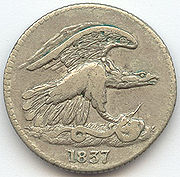
Feuchtwanger Cent
Encyclopedia

Lewis Feuchtwanger
Lewis Feuchtwanger was a chemist known primarily for his work on United States coinage.-Biography:...
during the 1830-40s in the U.S.
Lewis Feuchtwanger (Born in Furth
Furth
Furth is the name of several communes in Germany and Austria*Furth im Wald, Bavaria*Furth, Lower Bavaria, Bavaria*Furth an der Triesting, Lower Austria*Furth bei Göttweig, Lower Austria...
, Bavaria
Bavaria
Bavaria, formally the Free State of Bavaria is a state of Germany, located in the southeast of Germany. With an area of , it is the largest state by area, forming almost 20% of the total land area of Germany...
on January 11, 1805) received a doctorate at the University of Jena
Jena
Jena is a university city in central Germany on the river Saale. It has a population of approx. 103,000 and is the second largest city in the federal state of Thuringia, after Erfurt.-History:Jena was first mentioned in an 1182 document...
and then moved to New York City
New York City
New York is the most populous city in the United States and the center of the New York Metropolitan Area, one of the most populous metropolitan areas in the world. New York exerts a significant impact upon global commerce, finance, media, art, fashion, research, technology, education, and...
. He was primarily a mineralogist, metallurgist, and chemist
Chemist
A chemist is a scientist trained in the study of chemistry. Chemists study the composition of matter and its properties such as density and acidity. Chemists carefully describe the properties they study in terms of quantities, with detail on the level of molecules and their component atoms...
, but also worked as a physician
Physician
A physician is a health care provider who practices the profession of medicine, which is concerned with promoting, maintaining or restoring human health through the study, diagnosis, and treatment of disease, injury and other physical and mental impairments...
and was a member of a number of learned societies. He wrote four books on mineralogy and chemicals.
In 1837, to alleviate the need for small change during the Hard Times, Feuchtwanger created tokens made of argentan (commonly known as German Silver
Nickel silver
Nickel silver, also known as German silver, Argentann, new silver, nickel brass, albata,, or alpacca, is a copper alloy with nickel and often zinc. The usual formulation is 60% copper, 20% nickel and 20% zinc. Nickel silver is named for its silvery appearance, but it contains no elemental silver...
), an alloy made of copper, nickel, zinc, tin and trace metals. It was considerably cheaper to produce than the extraction of copper for the government minted half-cents and cents.
The Hard Times
Panic of 1837
The Panic of 1837 was a financial crisis or market correction in the United States built on a speculative fever. The end of the Second Bank of the United States had produced a period of runaway inflation, but on May 10, 1837 in New York City, every bank began to accept payment only in specie ,...
, an especially rough period of economic recession
Recession
In economics, a recession is a business cycle contraction, a general slowdown in economic activity. During recessions, many macroeconomic indicators vary in a similar way...
following the dissolution of the Second Bank of the United States
Second Bank of the United States
The Second Bank of the United States was chartered in 1816, five years after the First Bank of the United States lost its own charter. The Second Bank of the United States was initially headquartered in Carpenters' Hall, Philadelphia, the same as the First Bank, and had branches throughout the...
, was known for massive hoarding of small change. Much of the small change circulating at this time (roughly 1837-1844) was composed of clunky copper half-cents and cents privately produced or various cut and whole silver coins of foreign origin. In fact, it would not be until 1857, that Congress
United States Congress
The United States Congress is the bicameral legislature of the federal government of the United States, consisting of the Senate and the House of Representatives. The Congress meets in the United States Capitol in Washington, D.C....
would enact into law that legal currency be coin of United States Mint
United States Mint
The United States Mint primarily produces circulating coinage for the United States to conduct its trade and commerce. The Mint was created by Congress with the Coinage Act of 1792, and placed within the Department of State...
origin.
In 1837, Feuchtwanger presented his one cent coins to Congress for approval as legal coinage. This was probably the first attempt to circulate "nickel" coinage in the United States. Congress denied his request, but Feuchtwanger persisted in his production and circulation. Laws banning private coinage were not passed until 1864. Between 1837 and 1844 thousands of Feuchtwanger cents came out of his New York City pharmacy
Pharmacy
Pharmacy is the health profession that links the health sciences with the chemical sciences and it is charged with ensuring the safe and effective use of pharmaceutical drugs...
. To the discerning collector over a dozen different die casts have been identified, affecting the relative rarity of each specimen found.
Aside from one cent tokens, in 1864 Feuchtwanger also produced three cent tokens which are considered extremely rare, as few specimens have survived. Feuchtwanger was also noted for producing stamp-like casts featuring his common theme of a pouncing eagle attacking a snake.
He died in New York City on June 25, 1876.

